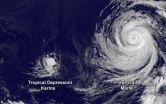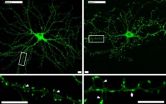(Press-News.org) Massive Hurricane Marie appears like a giant fish about to swallow tiny Tropical Depression Karina on satellite imagery today from NOAA's GOES-West satellite. Karina, now a tropical depression is being swept into Marie's circulation where it is expected to be eaten, or absorbed.
An image from NOAA's GOES-West satellite on Aug. 26 at 8 a.m. EDT shows Karina being drawn into the powerful and large circulation of Hurricane Marie to the east of the depression. The image was created by NASA/NOAA's GOES Project at NASA's Goddard Space Flight Center in Greenbelt, Maryland.
Forecasters at the National Hurricane Center noted that although deep convection could re-develop today, increasing easterly wind shear associated with the outflow of Hurricane Marie should make it difficult for any thunderstorm development to keep going.
At 11 a.m. EDT on August 26, Karina's maximum sustained winds dropped to 30 mph (45 kph) and was weakening. Karina was centered near latitude 16.6 north and longitude 127.3 west, about 1,210 miles (1,950 km) west-southwest of the southern tip of Baja California, Mexico. Karina is moving toward the southeast at 6 mph (9 kph).
Karina is expected to degenerate into a trough (elongated area) of low pressure and rotate around the southern portion of the large circulation of Hurricane Marie over the next day until it is absorbed by Marie.
INFORMATION:
Text credit: Rob Gutro
NASA's Goddard Space Flight Center
Satellite shows Hurricane Marie about to swallow Karina
2014-08-26
ELSE PRESS RELEASES FROM THIS DATE:
NASA sees huge Hurricane Marie slam Socorro Island
2014-08-26
NASA's Terra satellite passed over Hurricane Marie when its eye was just to the west of Socorro Island in the Eastern Pacific. Marie's eye may have been near the island, but the storm extended several hundreds of miles from there.
On Aug. 25 at 18:20 UTC (2:20 p.m. EDT) the Moderate Resolution Imaging Spectroradiometer or MODIS instrument aboard NASA's Terra satellite captured Hurricane Marie's center just west of Socorro Island. The image showed Marie's tightly wound center and eye. A thick band of powerful thunderstorms surrounded the center of circulation, and bands ...
Lack of naturally occuring protein linked to dementia
2014-08-26
Scientists at the University of Warwick have provided the first evidence that the lack of a naturally occurring protein is linked to early signs of dementia.
Published in Nature Communications, the research found that the absence of the protein MK2/3 promotes structural and physiological changes to cells in the nervous system. These changes were shown to have a significant correlation with early signs of dementia, including restricted learning and memory formation capabilities.
An absence of MK2/3, in spite of the brain cells (neurons) having significant structural ...
Existing power plants will spew 300 billion more tons of carbon dioxide during use
2014-08-26
Irvine, Calif. — Existing power plants around the world will pump out more than 300 billion tons of carbon dioxide over their expected lifetimes, significantly adding to atmospheric levels of the climate-warming gas, according to UC Irvine and Princeton University scientists.
Their findings, which appear Aug. 26 in the journal Environmental Research Letters, are the first to quantify how quickly these "committed" emissions are growing – by about 4 percent per year – as more fossil fuel-burning power plants are built.
Assuming these stations will operate for 40 years, ...
Brain benefits from weight loss following bariatric surgery
2014-08-26
Washington, DC—Weight loss surgery can curb alterations in brain activity associated with obesity and improve cognitive function involved in planning, strategizing and organizing, according to a new study published in the Endocrine Society's Journal of Clinical Endocrinology & Metabolism (JCEM).
Obesity can tax the brain as well as other organs. Obese individuals face a 35 percent higher risk of developing Alzheimer's disease compared to normal weight people.
Bariatric surgery is used to help people who are dangerously obese lose weight. Bariatric surgery procedures ...
Coal's continued dominance must be made more vivid in climate change accounting
2014-08-26
The world's accounting system for carbon emissions, run by the United Nations, disregards capital investments in future coal-fired and natural-gas power plants that will commit the world to several decades and billions of tons of greenhouse gas emissions, according to a new study from Princeton University and the University of California-Irvine published Aug. 26 in the journal Environmental Research Letters.
In the paper, Robert Socolow, a Princeton professor, emeritus, of mechanical and aerospace engineering, and co-author Steven Davis, a professor of earth system science ...
Competition for graphene
2014-08-26
A new argument has just been added to the growing case for graphene being bumped off its pedestal as the next big thing in the high-tech world by the two-dimensional semiconductors known as MX2 materials. An international collaboration of researchers led by a scientist with the U.S. Department of Energy (DOE)'s Lawrence Berkeley National Laboratory (Berkeley Lab) has reported the first experimental observation of ultrafast charge transfer in photo-excited MX2 materials. The recorded charge transfer time clocked in at under 50 femtoseconds, comparable to the fastest times ...
Expanding the age of eligibility for measles vaccination could increase childhood survival in Africa
2014-08-26
PRINCETON, N.J.—Expanding the age of eligibility for measles vaccination from 12 to 15 months could have potentially large effects on coverage in Africa, according to a new report published by Princeton University's Woodrow Wilson School of Public and International Affairs.
If combined with improvements to the vaccination process itself, such a change could help the country inch closer to the national coverage levels required for measles eradication. The findings were published in Epidemiology & Infection.
"The age of routine vaccination is usually set to around 12 ...
And then there were 10 -- unexpected diversity in New Zealand kanuka genus Kunzea
2014-08-26
At the stroke of a pen a New Zealand endemic tree has for the last 31 years been incorrectly regarded the same as a group of 'weedy' Australian shrubs and small trees. A New Zealand botanist has completed a 15-year study to reveal some surprises and discover astonishing cryptic diversity behind what was long considered a single tree species. The study was published in the open access journal PhytoKeys.
Known to botanists as Kunzea ericoides, this species was one of the many discoveries made in the north-western South Island of New Zealand by Jules Sébastien César Dumont ...
Best view yet of merging galaxies in distant universe
2014-08-26
An international team of astronomers using the Atacama Large Millimeter/submillimeter Array (ALMA) and the Karl G. Jansky Very Large Array (VLA) -- among other telescopes -- has obtained the best view yet of a collision between two galaxies when the Universe was only half its current age.
To make this observation, the team also enlisted the help of a gravitational lens, a galaxy-size magnifying glass, to reveal otherwise invisible detail. These new studies of galaxy HATLAS J142935.3-002836 have shown that this complex and distant object looks surprisingly like the comparatively ...
Surgery to repair a hip fracture reduces lifetime health care costs by more than $65,000 per patient
2014-08-26
ROSEMONT, Ill.—Each year, more than 300,000 Americans, primarily adults over age 65, sustain a hip fracture, a debilitating injury that can diminish life quality and expectancy, and result in lost work days and substantial, long-term financial costs to patients, families, insurers and government agencies. And while surgery, the primary treatment for hip fractures, successfully reduces mortality risk and improves physical function, little is known about the procedure's value and return on investment.
A new study, appearing in the journal Clinical Orthopaedics and Related ...






